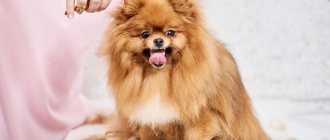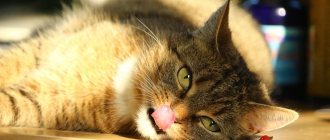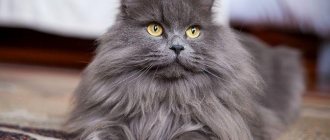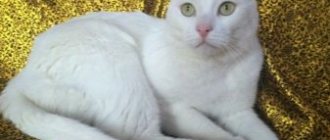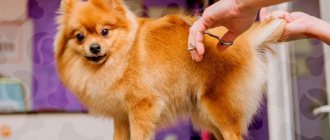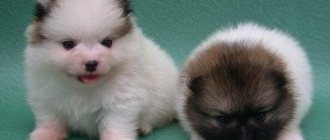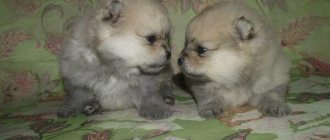Pomeranians are ideal pets for city dwellers with their tiny size and sweet personality.
They are best known for their lively personalities and adorable fluffy coats. However, did you know that the Pomeranian's fluffy double coat can come in over 10 different colors?
There are actually 13 different Pomeranian colors, ranging from pale cream to merle. Perhaps you'll fall in love with their famous orange coat, or maybe you'll love the rare tiger pattern?
Pomeranian Spitz color chart
There are 13 different colors of the Pomeranian recognized by the World Kennel Club.
Some colors, such as beaver and brindle, are less common than the more traditional red, orange, white and black. You can see a complete list of all coat colors in the table below:
| Color | Appearance | Popularity rating |
| orange | Bright orange without black markings. Gradient from light to dark orange. | 1 |
| red | A deep rusty red color with lighter cream fur on the chest. | 2 |
| white | Pure white with no cream or darker markings. | 3 |
| black | Solid black color. | 4 |
| Merle | Splashes of red on a brown base with splashes of white. | 5 |
| Wolf sable | Gray fur with black nose, eye rims, lips and paw pads. | 6 |
| Chocolate | Colors from milk to dark chocolate. | 7 |
| Blue | Silver-gray and dark gray guard hairs. | 8 |
| Cream | Pale fur that looks like a honeycomb. | 9 |
| brindle | With streaks of red, gold, orange and black. | 10 |
| Black and Tan | Fluffy, with black fur on the face and back, with tan on the chest and legs. | 11 |
| Beaver | Light brown in color, reminiscent of a pale cookie. | 12 |
| Tricolor | Black, brown and white pattern. | 13 |
Spitz color chart
Breed standard
An adult Pomeranian at the withers should be 18-22 cm. The weight of a dog to participate in the exhibition should be no less than 1.4 and no more than 3.2 kg, ideally 1.8-2.3 kg.
These dogs should have a dense, strong, but harmonious physique, a square body.
Breed standard:
- wedge-shaped head;
- the skull is small, tapering towards the nose, the stop is poorly defined;
- the muzzle is proportionate to the body, ratio 2:4;
- the nose is small, round, pigmented black or brown - depends on the color of the coat;
- the lips are weakly expressed, there are no folds in the corners of the mouth;
- straight or scissor bite, the absence of no more than 3 premolars is not considered a defect;
- cheekbones are rounded, not protruding;
- the eyes are small, almond-shaped, slightly slanted; the iris is black, and in individuals with brown fur it corresponds to its shade;
- the ears are triangular, pointed at the ends, set high and close, erect;
- croup short, straight;
- the chest is voluminous;
- the tail is bushy, set high and carried over the back;
- the forelimbs are straight, the shoulders are strong, with well-developed muscles;
- cat-type paws, rounded;
- the hind limbs are stocky and strong, set parallel;
- the skin fits tightly to the body, there are no folds.
Disadvantages for which participation in exhibitions is not prohibited include hereditary anatomical defects, an apple-shaped head and a too flat skull, large eyes, a lighter nose, and sudden movements.
NOTE!
Dogs with a crown that is not covered in time, an overshot or undershot eyelid, eversion or inversion of the eyelids, semi-erect ears, or obvious white spots in any color other than white cannot participate in exhibitions.
Pomeranian Spitz
© shutterstock
When dog lovers think of this breed, they think of orange. Breeders call the orange Pomeranian clear orange to distinguish this color from the orange sable. This color was developed by crossing an orange Pomeranian with a sable carrying a pure recessive gene.
These Pomeranians are often puppy-pale. It's a pleasure to watch them ripen and see their color change from pale creamy white to bright orange. Sometimes these puppies' sable coats also turn bright orange.
They typically lack black fur and are a lighter cream color with a gradient of light to dark orange. Orange Pomeranians are very easy to find and are recognized as an acceptable color in their breed standard.
Red Pomeranian Spitz
© shutterstock
The coat of a red Pomeranian is a dark red rusty hue with lighter cream fur on the chest. It is often confused with the subtler orange.
Red is one of the many colors that can be displayed in a ring. From a genetic point of view, they are similar to black Pomeranians because both colors belong to the E locus gene.
Red and orange are one of the two most popular colors.
White Spitz
© shutterstock
White Pomeranians are pure white with no cream or dark markings.
If you like the look of the Samoyed but want a smaller breed, then this white dog is perfect!
They are born white as puppies and remain this color throughout their lives.
White oranges are white due to the lack of pigment. They do not have the dark pigment melanin (i.e. black eumelanin) that dogs typically have. Due to a lack of pigment, albino animals have red eyes or pink noses. However, a white Spitz is not an albino because its eyes and nose are black.
This adorable Cloud Dog is perfect for anyone who dreams of owning a furry pet and requires the same care, exercise and nutrition as any other color Pomeranian.
Character and temperament
The Pomeranian is a good-natured, affectionate pet who is interested in everything that surrounds him. These dogs are curious and will not refuse the opportunity to learn something new.
Representatives of this breed are characterized by a positive attitude towards life and irrepressible energy. Those who are used to leading a calm and sedentary lifestyle or simply do not have enough free time to communicate and exercise with their pet should not get these dogs - Pomeranians love active games and long walks.
They are very attached to the owner and easily adapt to his usual way of life - the pet will not wake up the owner in the early morning if he is used to sleeping for a long time, but as soon as he wakes up, the dog will follow on his heels.
Thanks to their sociability and ability to capture people's emotions, these dogs get along with all family members, including children - Pomeranians happily play with kids and become their best friends.
IMPORTANT!
Representatives of this breed are very fragile, so they should not be owned by families with children under 5-7 years of age - a child may inadvertently injure the dog.
Pomeranians are wary and suspicious of strangers and will always inform their owner about a stranger’s visit with a loud bark, which makes them good watchdogs. In addition, these dogs are fearless, so without hesitation they will rush to protect the owner if something threatens him.
It is important to raise a dog correctly and from an early age, immediately showing it who is in charge in the house. Pomeranians tend to be dominant, which can become a problem as the pet grows up.
Black Pomeranian Spitz
© shutterstock
This Pomeranian is an adorable solid black color.
Known by fans as creatures of darkness, they still have the signature feisty spirit that we love about the breed.
The black color is created by the E Locus allele gene, which increases the production of black pigment and results in a solid black Pomeranian.
Be careful when taking your black Pomeranian outdoors, as the sun will gradually discolor their fur and result in a reddish-brown coat.
This color is perfect for those who like to wear black clothes as the fur that falls out will remain hidden!
Unrecognized colors
Some colors cause serious conflicts between representatives of the American Kennel Federation and the FCI. The first has less stringent requirements, and the following colors are acceptable:
- tricolor;
- blue;
- brindle;
- beaver;
- chocolate sable;
- blue and tan.
However, the World Federation of Canine Breeders firmly stands on its own, believing that all these options are a deviation, and their carriers should be immediately discarded and not allowed to reproduce.
Spitz puppies look like bear cubs
Creating and maintaining color standards is quite complex and painstaking work. And every breeder should know about them in order to be able to choose exactly the option that suits him and does not create unnecessary problems in the future.
Spitz merle
© shutterstock
Merle is a beautiful color pattern because the fluffiness of the Pomeranian's coat shows splashes of red on a brown base with splashes of white. This coloration is very similar to the Australian Cattle Dog. They are often seen as blue or red merles.
Their nose and paws are often variegated shades of pink and black, and their eye color can range from dark brown to blue.
This specimen was bred by mating a merle parent to a black or chocolate Pomeranian.
Make sure your breeder understands the risks associated with breeding Merle dogs. The Double Merle can be very susceptible to deafness or blindness. This is because the double merle gene suppresses certain pigment cells in the iris and cochlea.
This color will wow everyone at the dog park and is perfect for those looking for a splash of color on their pet.
Spitz sable color
© shutterstock
The wolf sable Pomeranian is sometimes called the gray sable because it looks very similar to the gray but has black-tipped guard hairs.
This gray variety has a sable pattern, which gives them a black nose, eye rims, lips, and paw pads.
The darkest parts are often the face, back and chest.
Wolf sable is one of the rarest Pomeranian colors and many are mistaken for orange sable. Finding a purebred Wolf Sable Spitz is incredibly difficult, even though the first one was shown in 1901.
The only way to be sure your puppy is a Sable wolf is to take a color gene test.
What size and color will an adult Spitz be? What does the size depend on?
I always advise you to go to the original source, i.e. to the breed standard. In the breed standard you will read reliable information about the correct name of the breed, sizes, colors. It is almost impossible to predict the size of a dog until a certain age. An exception may be extremely small puppies from birth. Usually by the age of 6-7 months it is possible to speak with a high probability of the size of an adult Spitz. I consider the age of 2-3 months not indicative for determining the size of a puppy. A puppy can be large from two miniature parents and small from a large mother. This is due to the fact that inter-height matings are allowed in Russia, i.e. mating between two different growth varieties of German Spitz. Plus complex genetic networks. Since small size is an artificially fixed sign of a miniature Spitz, the size of not only the parents, but also more distant relatives along the pedigree should be taken into account.
Relying on the puppy's weight is also often pointless. Because there is a significant difference in the weight of a Pomeranian and a German Spitz. Pom (short for Pomeranian), the American type of German Spitz is a heavy-boned dog, while the classic German Spitz is a lighter-boned dog. Therefore, the difference in weight is significant for two individuals of the same size, but not weight. The Pom is heavier than the German Spitz due to its heavy frame. This is a busier dog than the German Spitz.
Is it possible to buy a white, black, brown, party-colored Spitz from the Starpom kennel?
No. Our nursery has only orange breeders (including red, red sable, orange sable). Breeding only pure orange dogs is one of the rules of my kennel.
Why is the puppy's color gray? Can you trust if they promise that a gray puppy will grow into an orange Pomeranian?
The color of a Pomeranian puppy can be gray and gray with black hair and pure orange. As a result, a dog will grow up with the same orange color. Gray puppy color is a normal color. For greater reliability, you can look at the parents plus look at the pedigrees of the dogs. Plus, again, read the breed standard, where you will not find a gray, smoky color in a Spitz. The puppy's gray hair quickly changes to bright orange and red.
What kind of care does a Pomeranian or German Spitz require?
Being a fluffy dog, the German Miniature Spitz requires constant coat care: i.e. Regular brushing of the dog, trimming the nails, caring for the paws, eyes and of course washing the dog. Nowadays the dog cosmetics market offers a huge number of all kinds of products to keep your Pomeranian in perfect condition. I will not list all kinds of brands and brands. I will only say that the dog needs to be washed with shampoo and rinsed with conditioner. For combing, have a “slicker brush” and use it while the dog is shedding. You should also have a “claw clipper,” a metal comb for everyday brushing. When brushing your Miniature Pomeranian, I suggest using a detangling or anti-tangle conditioner. Always use conditioner when brushing your dog! After bathing, the puppy's coat needs to be dried with a hairdryer and combed.
After 5 months, you should monitor your bite and baby teeth more carefully. Around this time, the replacement of baby teeth with molars begins. It is impossible to say with absolute certainty whether teeth will change at 4 or 6 months; this is all individual, just like the fact that some Pomeranian puppies require the help of a veterinary dentist to remove their baby teeth.
Is it necessary to walk a dwarf Spitz?
This question is clear to me. Yes. Necessarily. No matter the size of your Pomeranian, walking is a must for owning a dog! Your Pomeranian may be trained to relieve itself at home in a litter box, but walking is key to your dog's physical and mental health! You should definitely take your dog for walks; this is necessary for the development of any animal. Of course, a dog can grow up on its own, but it is difficult to imagine that it will have the manners and social behavior that a person expects from it. For walks with your Spitz, I recommend a harness and tape measure. Don't worry, the harness won't dry out the luxurious fur during a short walk. But it will be much more reliable than a collar, from which it is very easy to break out. For a Spitz, a 3-meter tape measure is quite enough for active walks as well.
About the Show again
A question that remains eternal for a huge number of Pomeranian puppy buyers. What quality is the puppy: “SHOW”, “BRID” and “PET” class. The future owner of a puppy needs to understand before purchasing what kind of puppy he needs and for what purpose he is purchasing the puppy - as a pet or for breeding. And this is not a stupid desire of the breeder. Not all purebred dogs are suitable for breeding or for showing. Only the most worthy and healthy dogs that best meet the breed standard should be bred. The puppies are promising, i.e. SHOW class meets the breed standard and does not have disqualifying defects or major flaws at the time of sale. With proper raising and care of the puppy, the owner has every chance to raise a worthy representative of the breed, participate in dog shows, and with excellent training of the dog, receive high marks, as well as be in demand by the manufacturer. The price for a promising puppy is always quite high, regardless of the gender of the dog being sold. BRID class puppies - the puppy has no disqualifying defects, but there are deficiencies that may affect his successful career. If the future owner is not interested in showing and breeding your Pomeranian, you should pay attention to a pet-class puppy. A puppy in this category also has documents, he is also a purebred puppy, but in some respects he is not suitable for breeding and showing. These are disqualifying defects at the time of sale of the puppy and personal characteristics, for example, the puppy does not have the character of a show dog - an insecure puppy. Disqualifying defects do not pose any threat to the life and health of the puppy and do not in any way affect the quality of life. He will be the same great friend and favorite of the whole family. The cost of this category is lower than that of a show dog. The quality of the puppy will determine both the price of the puppy and its future life. That is why when buying a dog you need to clearly know your desires and not forget about your capabilities after weighing the pros and cons. Until about 8-9 months, the quality of the puppy is determined approximately and a transition from one class to another is quite possible after the puppy grows up. 03/28/2017
How active and restless are Spitz puppies?
Young animals, puppies, are more energetic than adult Pomeranians. This pattern continues until the Spitz puppies reach social maturity (18-36 months). However, the characteristics of the breed are such that the Pomeranian maintains a playful character and cheerful disposition throughout his life, being an active participant in all games. If you want to bring joy to your pet, buy him special dog toys at pet stores. Spitz loves toys that can squeak.
Keeping your Pomeranian safe.
To ensure your Pomeranian lives a long and happy life, every owner must keep their pet's safety in mind throughout its life. If you live in an apartment and walk your Pomeranian in the city, be sure to walk your dog on a collar, harness, or leash. This way you will prevent a lot of troubles, such as encounters with large dogs, cars, bicycles, etc. Don't be afraid to damage your Spitz's coat with a harness or collar. During a walk, it is impossible to wipe the fur down to the skin. When you get home, take off your walking gear until next time. For Pomeranians I recommend a 3 meter tape measure, for a Small Spitz - 5 meters. In the absence of the owner and interesting toys, the house turns into an amusement park, where the Spitz is looking for something to do. And sometimes this can end not only in material waste. Protect your pet from contact with electrical appliances. Remove from the dog's visibility and accessibility all electrical cords that are plugged into sockets and pose a real threat to your pet's life. Electrical appliances are one of the most dangerous items in the home. If there are small children in the house, take care to protect the puppy from contact with children's toys, as they can also be dangerous for a curious Spitz. A dog, and even more so a puppy, can easily swallow small parts during play, which can lead to surgery on the esophagus or stomach at best. Do not leave other potentially dangerous objects unattended on surfaces accessible to your Pomeranian. Make your pet's stay in the house comfortable for all residents. 08.12.2016.
Toys and treats.
The Pomeranian Spitz is an active and cheerful dog, which is probably why these dogs are ready to play with toys from early childhood to old age. For this reason, take the choice of toys very seriously, despite the fact that we are talking about games. It is better to purchase toys for dogs and puppies in pet stores. Toys for children often contain parts that a dog can chew off and swallow, which can lead to surgical intervention. I recommend stuffed animals with squeaks. The Pomeranian will quickly understand how to extract sound from such a toy and can play with it for a long time. For outdoor games, of course, choose balls; your Spitz will quickly master the command to bring you a ball, and walking with your pet will bring pleasure to both the dog and the owner. Do not buy balls that are too large or, conversely, too small. When choosing a ball, you need to understand its size so that the Spitz can easily take the ball into its mouth without swallowing it. It can also be squeaky, which will make it even more interesting for your pet. For games at home, in addition to soft toys, you can use plastic ones, for example, bones with the addition of bone meal. Such treats are very attractive, they have a natural aroma, perceptible only to the dog, and a natural taste. At the same time, the owner is sure that the Spitz will not be poisoned, will not bite off a piece and will not choke. Thus, the dog toy market is very diverse and interesting. Choose the right toys and you will have peace of mind, a whole house and a busy dog. 08.12.2016.
What to feed your Pomeranian Spitz?
Nowadays, when everyone is very busy at work, the best feeding option is ready-made food. To feed your Pomeranian, choose the best - Super, Premium food. I don't see the need to combine dry and wet food. The main thing is the highest quality product. What kind of flavor it will be - fish, lamb, beef, rabbit, turkey or chicken - choose for yourself based on the preferences of your Pomeranian. Lamb is generally considered hypoallergenic, fish foods are grain-free (potatoes replace them), chicken is traditionally suitable for all ages, and is enjoyed by puppies to adult dogs. It must be remembered that when keeping a dog on dry food, be sure to ensure sufficient water consumption, which should always be fresh, clean and easily accessible. The amount of protein and fat is normal. For a Spitz, 21-26% protein and 12-16% fat are sufficient. This is optimal. If your dog has certain problems, you need to consult a doctor and choose a veterinary diet. In case of acute and chronic disease, the diet is prescribed in the first case for about a month, in the second, lifelong consumption of a veterinary diet is possible (for example, in case of renal failure). 06/29/2019.
I feed my dogs dry food. But like any person, I can’t resist giving the dogs a treat. Yes, I give dogs meat, cottage cheese, eggs. My dogs also get some vegetables and fruits as treats. The little Spitz eats 4 times a day, then, by 9 months, we gradually reduce the feeding frequency to 2 times a day. All these dates are individual and approximate. The food itself is also distinctive. Puppies require special food, higher in calories, which is necessary during the period of intensive growth.
Is it possible to cut a Pomeranian's hair short?
Recently, there has been a fashion for short haircuts for Pomeranians. This is due to the fact that many photos of a Pomeranian named Boo have appeared on social networks. The owner of this Spitz gives her pet a clipper cut and was able to make him a star, primarily due to her creative ideas. Unfortunately, this turned out to be a blow for Spitz dogs in general. Dog grooming has begun, and this causes enormous harm to the condition of the dog's coat. The Spitz's coat is such that it does not require a drastic haircut. And cutting a haircut with a clipper or extremely short changes the structure of the hair. And then, after a haircut, getting a fluffy, beautiful dog again becomes not only problematic, but practically impossible. The structure of the hair changes, becomes wadded, becomes tangled and very difficult to care for. This occurs because the awn, which by nature serves as protection for the undercoat, is removed and the undercoat, soft and fluffy, remains unprotected. The axis grows more slowly and thus the dog changes color and the hair structure deteriorates, which takes years to restore. This statement is more correct for Pomeranian Spitz males since females change their hormonal levels 2 times a year and estrus also occurs, which contributes to a rapid change of coat. So females recover faster after cutting than males.
I generally do not recommend such haircuts to my clients.
Pomeranian Boo looks impressive primarily due to his type of real Pomeranian, very beautiful head, expressive eyes and bright personality.
Do Spitz dogs need vitamins and nutritional supplements?
If you feed your German Spitz super premium dry food, your dog will not need any additional vitamins. If your dog receives natural food, you must add vitamins to its diet. There are also nutritional supplements used at different periods of the life of the Pomeranian Spitz - in childhood, for the formation of the skeleton, teeth, during molting, for coat, during physical activity, for joints, and much more. other.
From about 4 months we introduce vitamins with calcium into the diet for a month to a month and a half. From 6 to 7 months we change vitamins to preparations with glucosamine and chondroitin. We give the supplement for about 2-3 months. By the age of one year, we change the drug to vitamins for fur and give the same to the dog for about a month. For an adult dog, I would keep the skin and coat vitamins and multivitamins.
For older Pomeranians, medications with glucosamine and chondroitin to maintain healthy joints are more relevant, plus medications for individual indications, as well as medicinal foods that may likely be needed.
How to toilet train a puppy?
Some recommendations that will help you, with your desire and persistence, to train your dog to the toilet. Firstly, do not forget that you will need patience and regular, methodical observation of the puppy. Know that your time will not be wasted. And if you are a good teacher you will complete this task in a week, if you cannot train the dog regularly or cannot convey your wishes to the dog, you may spend more time than a week, but you have years of life ahead of you, so approach the task persevere and don’t give up your achieved successes halfway. To begin with, it must be said that a dog remains a puppy for up to 9 months and it is quite stupid to demand from a two-month-old puppy to fully perform his duties in the tray. Next, it should be noted that puppies often grow up in playpens, where they actually wear a diaper and newspaper. A small space quickly orients the puppy where the toilet is, where the resting place is and where the food bowl is. Remember, Spitz, like all animals, are clean from birth! Don't forget about this when training to a tray or place. The main thing is that the dog understands WHAT YOU WANT. And she will do everything just out of love for you, because she loves you and doesn’t want to upset you in any way! To begin with, when picking up a puppy from its parent’s house, find out what the puppy was accustomed to - diapers or newspapers, or walked outside. Use the same material at home. At least for the first time. • Take the puppy out more often, immediately after sleeping, eating, playing, or walking. • Allow your puppy to sniff his litter box. • Praise the puppy as soon as he sits down, possibly giving him a treat. • Don't physically punish your puppy! This can cause fear and the puppy will begin to relieve itself, avoiding open places where the tray is located (for example, behind a curtain so that the owner does not see - after all, the puppy has been punished). • Be consistent and persistent. • Be patient. Remember that we also teach a small child useful skills and develop useful habits in our children. • Choose a place for the toilet so that it is accessible to the dog 24 hours a day. • Try to distract the Pomeranian Spitz when he crouched in the wrong place, without needing to frighten or scold him. You just need to attract attention - you don’t need to knock or shout, you can just say “oh” loudly so that the puppy is distracted from his business. • At first, you can have several places for a toilet at home. The first stage of consolidating going to the toilet is. The number of diapers can then be reduced to the required amount. • Remember, locking your Pomeranian in a playpen is not a solution to the situation. A dog is a social creature, it needs you and will be very unhappy if its life is spent in a playpen. Keeping a Spitz in a playpen leads to the dog mistaking it for his home and his apartment for the street. This is absolutely normal for a small dog. Thus, she will tolerate and not go to the toilet in the playpen (this is a house, after all) and will begin to perceive the apartment as a place for walking. Once again, don't scold your dog! Leave silently, without commenting on her misconduct. I want to tell you about an incident that happened to my puppy in a new home. The new owner of my puppy described his dog’s behavior as unclean, only at home and behind the sofa or curtain. They walk the dog, but she doesn’t do anything outside, and when she comes home she relieves herself, hiding behind the sofa. During the conversation, it turned out that the owner was punishing the dog for unclean behavior at home. What happened? The dog understood only one thing - they scold her when they see that she goes to the toilet. She cannot understand that she is being scolded only for doing her business in the house, but she knows one thing - the owner is unhappy that she is getting dirty. During a walk, the owner is nearby, and she does nothing with him. Thus, when walking, again, remembering the punishment, she endures. And hides in the house so as not to be punished. This example very eloquently shows how important it is to correctly formulate your desires so that they are understandable to the animal!
What documents should a puppy have? Why don't they give me my pedigree right away?
When purchasing a puppy, you must be given a veterinary passport with vaccination records. Also, if the puppy’s parents are registered in the RKF, you must be provided with a puppy card issued by a club or kennel, which the puppy’s owner can exchange for a pedigree. The exchange is carried out at the RKF (Russian Cynological Federation). A sample puppy card can be seen on the official website of the RKF. To avoid troubles when buying a puppy. A pedigree is a document confirming the origin of a dog. The document itself is a laminated sheet of A4 format. Since the document is laminated, it is not possible to enter the owner, so puppies are sold using puppy cards and subsequently exchanged for pedigrees.
Traveling with a Pomeranian Spitz together.
From time to time, almost everyone needs to travel (vacation, business trip, etc.) with a dog. Therefore, questions and concerns about this are quite understandable. In my opinion, the first and most important issue is purchasing a ticket. When purchasing a ticket, if you are traveling by public transport, you must declare your pet. If you are traveling by train, choose a carriage that allows your Pomeranian. If you are traveling by air, when purchasing your air ticket, contact the airline and request that your dog travel with you. Over the phone, the airline representative must give you permission to carry your dog. ONLY after receiving permission you can safely buy a ticket. You must strictly comply with all airline requirements (carrying size, weight), otherwise you may be denied boarding already at the airport, during check-in. Once permission to transport a dog has been received, the following steps must be taken. Buy a carrier (dog bag) that fully meets the requirements of the carrier. When flying within Russia, veterinary certificates are canceled; you must have a veterinary passport with vaccination records in the proper amount according to the age of the Spitz. We issue certificates only for trips outside Russia. Certificates are issued by state veterinary stations, if the dog has a veterinary passport with vaccinations and full quarantine (this is a requirement for puppies. From the date of rabies vaccination - 21 days, for Europe, other countries - 30 days from the date of vaccination). The dog must also have a chip. So you're almost ready to go. You have purchased tickets, a carrying bag, you have all the documents: a veterinary certificate and a veterinary passport. Don't forget to bring food with you. After all, it may well happen that there is no food in your new place and you have no time to look for it. For the trip, stock up on the required number of disposable diapers and napkins. Don't forget a water bowl. I hope that you took everything with you and then your trip will be easy and not tiring. 06/29/2019.
How much does a Pomeranian cost?
Perhaps this is the first and sometimes only question that I hear more often than others. To the great chagrin of many, I cannot answer this question unequivocally; there are many factors that influence the price of a Pomeranian. The main factor is breed!!! Yes, exactly the breed. So, it is impossible to buy a purebred puppy with documents absolutely cheap. Even a Pomeranian with a deficiency can be expensive. If the dog is a pet, the price is lower; if a dog has no flaws, the cost increases. But here everything is not so simple. There are Pomeranian Spitz from which you cannot buy puppies on the open market, or you have to wait a very long time, such dogs are very expensive and puppies from these producers will not be cheap. And there are Pomeranian Spitz dogs that have no value in breed circles. And despite the fact that the puppy has no flaws, it is sold quite cheaply. Other factors are the presence of exterior characteristics of the puppy and the absence of disqualifying defects. Up to 2 months of age, a puppy may not have these factors. This is why I do not evaluate puppies under 2 months and do not put them up for sale. In kennels with dogs of interesting “blood”, puppies always have a high price, because often these puppies will grow up and form the breeding base in other kennels. Our nursery's Spitz dogs have a high price. The high rating of our dogs can be easily seen from the fact that more than 70% of our graduates are purchased by other kennels. You can see puppies with the Starpom prefix in the nurseries: • "Game Time" - Kaluga - ("Starpom Mitra") • "Luxori Pom" - Nalchik - ("Starpom Luxori") • "Darikar" - Kharkov - ("Starpom Deep Emoushin" ", "Starpom Zest Selekshin") • "Pomfavorit" - Bulgaria - ("Starpom Candy") • "Damerino" - Kazan - ("Starpom Morris") • "Malpom" - Moscow - ("Starpom Roxalana") • "Altironenex" " - Vladimir - ("Starpom Willie") • "Oroslando" - Kaluga - ("Starpom Ariadne") • "Leoria Life" - Kirov - ("Starpom Lucky Beti") • "Natalie Lux" - Tver - ("Starpom Harry ) • “Angel of Eden” - Israel - (“Starpom Charlik”) • ..... The quality of my dogs is time-tested. However, if we talk specifically about the cost of puppies in my kennel, then it is higher than the price tags that are plastered in large numbers on popular message boards. 02/10/2017
Why do they use different names for the same breed?
Yes indeed. We are constantly faced with the fact that we hear either a Pomeranian Spitz, or a German Spitz, or a dwarf Spitz. Which name is correct? Since July 18, 2012, Pomeranian and Miniature Spitz have been officially adopted by the RKF as the names of the German miniature Spitz.
Transition period from Pomeranian puppy to adult dog
In the life of every Pomeranian puppy there is a period of unprepossessing Spitz - from approximately 4 to 9 months of age. Photos of Spitz dogs of this age category are rare on the Internet and here’s why... read more
What you need to know before buying a Pomeranian
Recommendations for choosing a puppy are placed on a separate page.
Chocolate Pomeranian
© shutterstock
Chocolate Pomeranians can range in color from milk to dark chocolate, and their nose and paw pads are often the same silky brown color.
The chocolate color is caused by the B Locus gene, which creates a black pigment that darkens a dog's coat. The mutation dilutes this pigment and results in a chocolate-colored coat.
Like many dogs with darker coats, they do best when not exposed to direct sunlight for long periods of time. Sunlight will redden the coat and make it harder to see the chocolate color.
This dog is a great choice for any owner who wants to walk a teddy bear.
What do the puppies look like?
During 1 year of life, the appearance of Pomeranian Spitz undergoes significant changes, which every owner of such a dog should be aware of.
Up to 1 month
Puppies are born weighing 55-125 g, they have no hearing or vision, they are absolutely defenseless and very vulnerable. The body of such babies is disproportionate: the head is large and compressed, the body is elongated, the stomach is voluminous, and the legs are short. The body is covered with faint down, through which the skin is visible; its color indicates what shade the dog's coat will be.
Blueness is a sign of the presence of any pathologies.
About 2 weeks after birth, puppies' eyes open, and at 17-21 days, their ear canals open. At the beginning of the 3rd week, babies can empty their bowels on their own, and at the end of 1 month they stand well on their paws and move actively.
Up to 2 months
At 3 weeks after birth, puppies begin teething, causing their gums to become swollen and itchy. Little Pomeranians behave restlessly.
The period from 4 to 8 weeks after birth is associated with laying the foundations of the dog’s behavior and character; at the end of 2 months they are ready to move to a new home.
3 month
The so-called baby or puppy hair begins to be replaced by an adult one. You can already determine the color of the dog.
4-5 month
At this age, puppies do not look very attractive - new hair grows gradually, which is why they seem to be not fully dressed. At the same time, the replacement of milk teeth with molars occurs.
The body of Pomeranians acquires the proportions characteristic of the breed.
6-9 month
Shedding is still ongoing, the change of teeth ends by the 7th month. In some individuals, the molars grow next to the lost milk teeth, which in such a situation must be removed at the veterinary clinic.
At 8 months, Pomeranians can already participate in their first show.
1 year
In bitches, at 9-12 months, puberty begins and the first heat begins. Another molt is taking place. The Pomeranian coat acquires its final appearance by the age of 3 years.
CAREFULLY!
You cannot breed a dog during its first heat. This will negatively affect her health.
Blue Spitz
© shutterstock
This Pomeranian is born silver-gray and has dark gray guard hair with a blue undercoat.
Blue is a color recognized by the American Kennel Club and is easy to admire.
Blues are bred from two solid-colored parents who carry a diluted gene.
There are health concerns associated with any blue dog because they have a chance of hair loss caused by dilution of the color, leading to hair loss and dry skin.
A blue Pomeranian purchased from a reputable breeder will make a wonderful companion.
Cream Pomeranian
© shutterstock
The Cream Spitz is a beautiful dog with light fur. This cream-colored dog is often born white, but after a few months its coat darkens to cream.
One of the genes involved in creating the cream color is the E Locus gene, which also gives the red Pomeranian color.
This color variety requires careful grooming as their fur shows up easily on clothing.
Grooming
Since I’ve mentioned the transformation of an animal’s coat so many times, it’s worth highlighting its care as a separate topic. I would like to immediately note that, in addition to the above-mentioned change in coat depending on age, girls shed their fur coat after childbirth. And you shouldn’t expect recovery earlier than six months later.
Therefore, I advise you to be wary if the breeder shows the furry mother of a 2-3 month old puppy - this does not happen
But after 6 months the lady will look gorgeous again.
Perhaps I will surprise some readers by the fact that this dog’s fur needs to be processed against its growth. You need to carry out such combing in the direction from the tail to the head with a special brush - this is an excellent prevention of tangles. In normal times, thorough brushing once a week is sufficient. During the molting periods I indicated - daily. There is a misconception that grooming an animal under one year of age is undesirable. This is where some owners suffer, dreaming of showing their pet at an exhibition, but afraid to make it look well-groomed. In fact, this procedure does not fall under age restrictions. Some experts even recommend cutting your animal's hair from puppyhood so that it gets used to scissors and later does not associate them with anything terrible.
brindle spitz
Brindle pattern dogs have stripes of red, gold, orange and black.
The Pomeranian's long coat serves as a canvas for layers of earthy tones.
Brindle is more of a pattern than a color and results in dark stripes. The darkest spots are usually the paws, ears, muzzle and back.
Some are more gray in color and some are brown.
The brindle pattern is caused by the recessive "EE" E Locus genotype.
Each brindle color is different, so you can be sure to get a unique dog.
Breeding Spitz dogs by color or how to avoid marriage
Breeders cannot always say exactly what color an adult pet will be . Therefore, if you want to seriously engage in Spitz breeding, you need to more carefully study the pedigree of the parents and their ancestors, taking into account what shades were found in this genetic branch.
You will need to be patient and painstaking, since in some countries breeders do not indicate the color of the parents in the pedigree and metrics. Or there are differences in the names of colors in different countries, for example, the American names of colors differ from European ones.
Quite often you can tell what color an animal will grow up by looking at the color of the fur behind its ears, but this is not an exact guarantee. But, if you are taking a puppy for a family, then you will agree that it will not be so important for you if the puppy’s color changes. After all, after the first hours of your baby’s stay at home, you will fall in love with him forever, not paying attention to the shade of his fur.
Black and tan Spitz
© shutterstock
The Black and Tan Pomeranian is a color variety with a black and tan pattern. They are fluffy, with black fur on the face and back, and tan on the chest and legs.
Light brown highlights highlight the breed's characteristic pointed eyebrows and give them a sweet and charming appearance. Many have adorable dotted markings above their eyes that resemble eyebrows.
Charming and sassy is the best way to describe this color.
They are very similar in genetics to sable Pomeranians, as they share the same recessive allele.
Black and Tan Pomeranians are unique and look similar to the smaller Rottweiler or Doberman Pinscher.
Anyone who loves the appearance of these breeds but prefers to have a dog that is suitable for apartment living will be delighted with this dog.
Contents in the apartment
The small size of the Pomeranian allows it to be kept even in a small apartment. Before buying “fluffy joy” you need to prepare not only the place, but the entire room. Move small items from the floor, shoes, household chemicals, building materials to a cabinet with a securely closing door. Remove carpets and rugs until the Pomeranian gets used to the tray. Protect access to wires and hazardous household chemicals. If the puppy is left at home alone, you can arrange a small enclosure for him. This is a reliable way to protect the environment from a playful baby and the dog himself from danger.
Difficulties with raising a Pomeranian will definitely arise, but this is true for any breed. And dogs are undemanding when it comes to grooming. They rarely get sick (if there are no hereditary diseases), take care of their fur like cats, and are unpretentious in food. In addition to training, feeding and walking, the owner needs to regularly comb the Pomeranian's long, thick coat.
